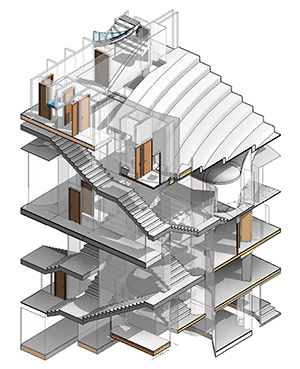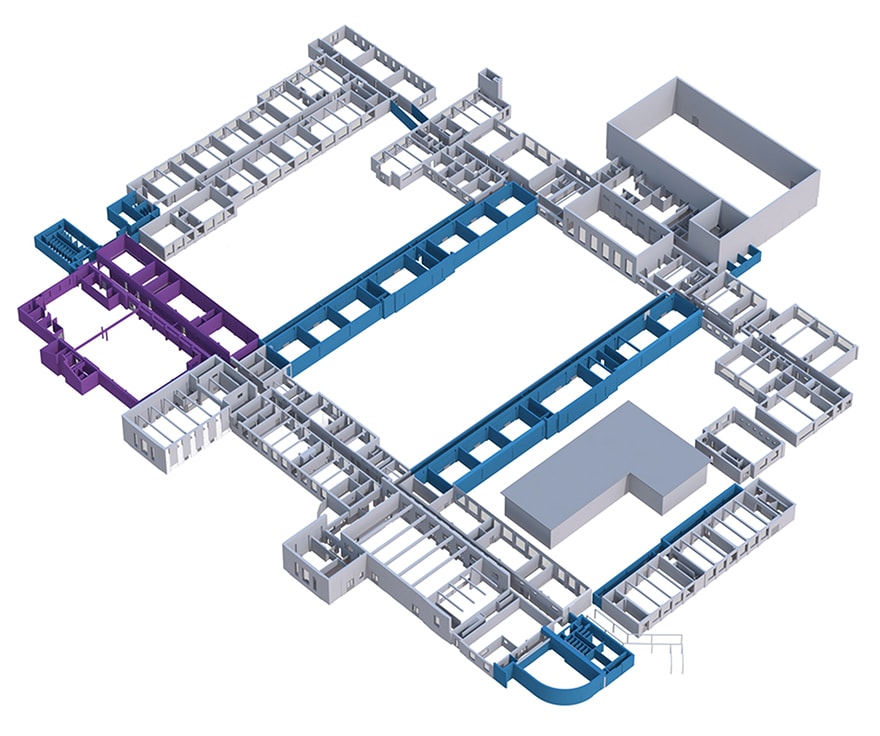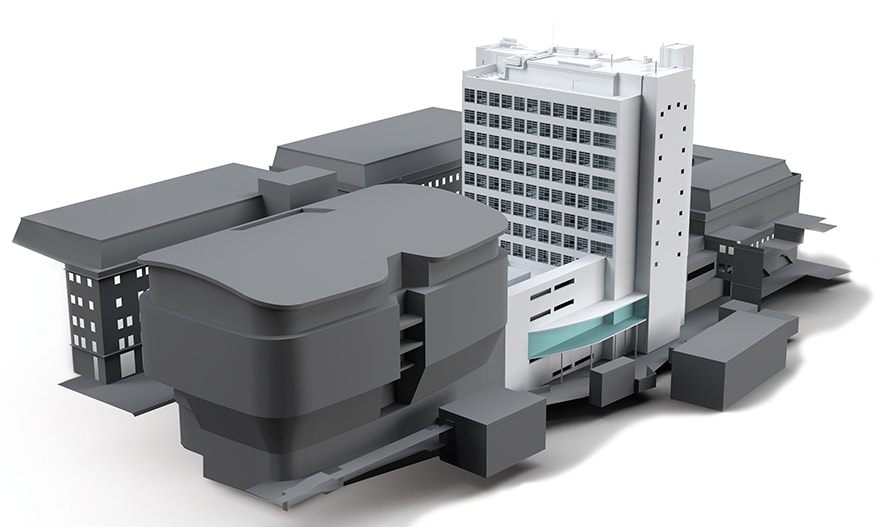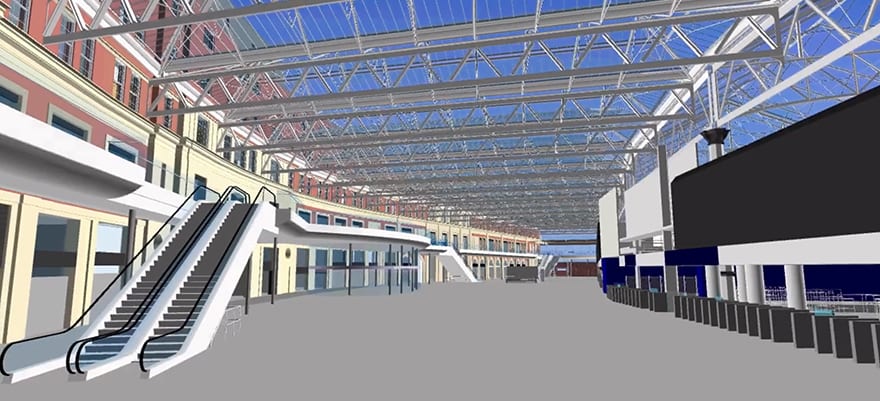Mention BIM to most people and it will conjure up ideas of crisp 3D computer-generated models of new buildings filled with complex MEP services concealed inside the walls. But a new world is emerging around the use of BIM on retrofit projects, using various sources of survey data to create datasets from which to plan refurbishments, renovations and conservation projects, or to plan new build projects that interact with existing structures.
New software and scanning technologies are improving the accuracy of BIM retrofit models, while reducing the time and cost required to put them together. The latest 3D laser scanners are capable of capturing geometric data across large surfaces to accuracies of +/-3mm and at speeds of up to a million points per second, while innovative digital photogrammetry software, such as AutoDesk’s ReCap Photo or its free counterpart 123D Catch, enable users to develop less complex 3D surveys using a smart phone camera, or a camera on a flying vehicle or drone.
But BIM’s move into the realms of retrofit is not without challenges. Contractors feel that BIM software packages, such as AutoDesk NavisWorks or Bentley AECOsim, need to simplify the process of converting point cloud data from 3D laser surveys into BIM objects such as windows or columns, which in most cases is still done manually. And uploading large 3D data files to a desktop system is still time consuming.
There is also a lack of commonality among BIM practitioners over the extent of laser surveys and levels of detail the associated BIM retrofit model should include, explains Robert Klaschka, director of architect Studio Klaschka. The practice recently created a BIM model of existing buildings on a site in Enfield for Bouygues UK as part of its bid to redevelop the Ark John Keats Academy.
“When builders commission a 3D laser survey from a surveying company they often get it produced to a high level of detail across the entire project, then find they are demolishing or stripping out buildings they have paid top dollar to have modelled, complete with all their interior fixtures and fittings,” says Klaschka.
“The latest laser scanning equipment is able to deliver high levels of geometric detail, but creating a BIM model with that level of accuracy is pointless if, for example, you’re just redecorating a room.”

The Teatro Unico in Milan
Levels of complexity
The process also threatens to create unwanted levels of complexity when preparing a BIM model, adds Klaschka. “If the survey reveals that the walls or floors are not entirely flat, do you take the time to model that in BIM or simply model it flat and add attribute information explaining it? The industry still has a long way to go to understand how all of this will fit together and work effectively.”
Developing a BIM model of an existing building can be challenging as original 2D drawings and records of any subsequent additions are often inaccurate or missing. A full 3D scan using a high end scanner such as a Leica ScanStation can help fill in any gaps, but the technology can be prohibitively expensive and therefore not practical on smaller jobs.
Main contractor Vinci Construction found itself working with a patchwork of survey information when preparing a BIM retrofit model for development of the Whitechapel Crossrail station, currently under construction in east London.
The project is being carried out in joint venture with contractors Balfour Beatty and Morgan Sindall and involves construction of two new 30m-deep concrete station access shafts, an integrated ticket hall, connections to allow easy passenger interchange between Crossrail and the Hammersmith and City, District and Overground lines, platforms, and a 1,200-tonne station concourse bridge and canopy.
The BIM model, produced in Bentley AECOsim, was needed to coordinate the design and installation of services through the shafts and highlight areas where new build elements interact with the existing station. It also links with 4D project planning software to coordinate the ongoing construction work.
“Recreating the existing structure from different survey resources, which included a 3D survey model provided by Crossrail’s designer and more conventional 2D surveys, has been a big job,” says Yazhe Li, building information modeller at Vinci Construction. “Although the files were easy to federate because they utilise the common DMG format, the survey information was often conflicting, which made it difficult to decide the most precise information to include. Part of the Vinci job involves diverting existing signal cabling, but because we didn’t have survey information around these elements, just site photos, we had to exclude them from the model.”

The Ark John Keats academy
Although the 3D point cloud data provided valuable detail on some existing structures, manually converting it into 3D BIM objects that could be tagged with attribute information was labour intensive, she adds: “There needs to be a more convenient way of doing it, perhaps using software that can automatically recognise certain shapes and convert them into objects. I expect that will be where the software evolves in future.”
The process of converting point clouds into BIM models, more commonly known as Scan-to-BIM, is still in its infancy and while there are some applications on the market that offer some interpretation of the cloud, such as finding vertical faces and defining them as walls, the technology has a long way to go.
Important research in this area is being done by the Dublin Institute of Technology (DIT), which is pioneering the concept of Historic BIM, or HBIM.
BIM modelling is essentially based around 3D CAD software with parametric and other information added into the library of objects that make up a building. DIT has extended that concept and created a BIM library of parametric objects specific to historic buildings, such as Victorian and Georgian windows and classical ionic, doric or corinthian columns. In addition, it has developed software that is able to map the complex shapes of historic building details onto point clouds in a process intended to speed up the BIM modelling process.
“The HBIM project basically involves getting one 3D world to communicate with the other,” says Dr Maurice Murphy, who heads up the research at DIT. “The current problem when creating historic buildings in BIM is the library of historic objects doesn’t exist as sophisticated parametric parts. We have found a solution to that aspect and also introduced a scripting language called geometric descriptive language to enable better automation when mapping 3D objects.”
Other technologies have been developed to speed up the surveying process and make point cloud data simpler and more readily available. Laser scanning traditionally involves putting up reference targets throughout a building before completing a survey, which are automatically recognised by the software and aligned to a pre-defined grid.
However, Autodesk’s ReCap application is able to align the survey data without the need for targets, saving time on site, and allowing an engineer to check the captured data directly at the workface on a laptop rather than needing to return to the office and view it in Revit.
The ReCap system was recently used by the municipality of Milan in Italy to create a highly detailed 3D model of the Teatro Lirico, one of the city’s oldest public theatres built in 1779 for opera and ballet performances, but subsequently converted several times including during Mussolini’s fascist rule. Apart from creating a valuable historical record of the theatre, the data informed development of a detailed BIM model, which will be used by the contractor that’s awarded the contract to carry out the theatre’s forthcoming renovation.
“The only records of the building available were old 2D drawings that were completely inaccurate, laser scans were the only means of accurately capturing the state of the building as it is today,” says Tatjana Dzambazova, senior product manager for reality capture at Autodesk.
Over four days, a Leica laser station was moved in 550 positions to capture 10 million points and targetless registration allowed ReCap to quickly create the 3D point cloud, which is also in colour to help users visualise the space. The point cloud was used as a reference by architects to create BIM model with material attribute data added by students at a local polytechnic.
Meanwhile, Bentley is developing software that will speed up the process of accessing point cloud data files, which on larger projects can be several terabytes in size, by allowing smaller portions of data to be streamed directly into BIM.
“If you you are just streaming 100MB of points to the local areas of the model you are working in, instead of having to reference entire point clouds into the application, it could become a very powerful and fast piece of technology,” says Robert Klaschka. “It will also be able to run on mobile platforms, providing an incredible tool for working on retrofit projects,” he concludes.
Severn Partnership pioneers Scan-to-BIM at Brighton Hospital

Sussex County Hospital
Laser Scanning involves shining a laser line over surfaces to collect 3D data. The surface data is captured by a camera sensor mounted in the laser scanner which records accurate 3D points in space. These are combined to form a point cloud that represents the surface surveyed.
Point clouds can be viewed in multi-hue colours (based on signal intensity return) or true colour from a digital camera. The data can also be linked to topographical surveys, or elevations and sections.
Scan-to-BIM involves creating a 3D BIM model from surveyed 3D laser scan data, as with this example of the Sussex County Hospital site in Brighton. Specialist consultancy Severn Partnership scanned the Royal Alexandra Children’s Hospital, completed in 2004, which sits in a complex of older buildings. The surrounding site is due to be redeveloped (subject to Treasury approval) and the design and construction team wanted an as-built BIM model. Severn Partnership’s 3D BIM modellers were able to accurately recreate the site using Autodesk Revit from the laser scan data.
Severn has now taken Scan-to-BIM a step further in its Seeable app, where laser scan data is used to create 3D models in a Unity games engine with BIM attribute data added. The result is a “serious game” that allows users to explore the models and read the attribute data.
Laing O’Rourke’s BIM model arrives at Waterloo
A complete BIM model of London’s Waterloo Station has been built by Laing O’Rourke for Network Rail.
The BIM model covers the entire station’s infrastructure, including the main platforms and concourse, the international terminal, Waterloo East, the underground tunnels beneath the station and the external facades, and was created using a mixture of existing drawings and new laser scanning data.
The model will be used by the client to plan the future development of capital works at Waterloo over next seven to 10 years. The model was a standalone contract for Laing O’Rourke, with no building works involved or even scheduled.

The model will have sufficient detail to include individual elements such as columns, steel I-beams and parts of track, each embedded with attribute information including material, finish and dimensions.
The contractor’s surveying team had to work late shifts to avoid any disruption to commuters, setting up an advanced Leica laser scanning station in hundreds of positions after the last train at around 12.30pm.
Converting the mass of point cloud data into usable 3D object information was a challenge, says Chris Northwood, digital engineering lead for Laing O’Rourke: “Our scanners recorded millions of points that are stitched together to give a highly accurate representation of a room’s geometry and individual features.
“Traditionally the data would have been used to generate a mesh representation of objects, but we had to adapt that information to create objects that can be clicked on and embedded with information. It makes things much smarter than before.”
The BIM model was built using a combination of Autodesk Revit and Graphisoft’s ArchiCAD software. Mapping architect Nicholas Grimshaw’s famous zig-zagged roof over the international terminal was particularly tricky and meant utilising a different software package to deliver the required results.











